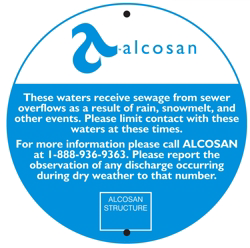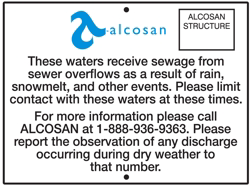A combined sewer overflow (CSO) occurs when stormwater and untreated, diluted sewage, carried in a single pipe, overload the sewer system and flow into rivers and streams. CSOs can carry a variety of pollutants.
Advisory Programs
ALCOSAN's Sewer Overflow Advisory Key (SOAK) and CSO Flag Alert Program are complimentary advisory programs to warn the general public of possible river contamination from CSOs. While these programs do not prohibit or discourage river recreational activities, they do caution recreational users to limit contact with river water when boating, fishing, water skiing or engaging in other river recreational activities.
Advisory Programs operate annually from April 1 until October 31 to coincide with ALCOSAN’s NPDES permit summer reporting period. The program will operate between the hours of 8 a.m. and 7 p.m., 7 days a week. If overflows occur during this timeframe, ALCOSAN will raise orange CSO flags at designated points along the waterways and will notify the public accordingly via the ALCOSAN website-based SOAK program, and our subscriber-based text/email notification program. Users will also be notified when overflows have ceased, as well as when the system returns to dry weather operation, 48 hours later. At this point, CSO flags are also lowered to indicate dry weather operation.
CSO SOAK Alerts
-
August 22, 2025
System is in dry weather operation; No advisories are in effect
In: 08/20/2025 - 03:40 AM
Out: 08/20/2025 - 05:03 AM
Dry: 08/22/2025 - 05:03 AM
-
August 20, 2025
Overflows have ceased; Waterways may still be impaired.
In: 08/20/205 - 03:40 AM
Out: 08/20/205 - 05:03 AM
-
August 17, 2025
Overflows have ceased; Waterways may still be impaired.
In: 08/17:2025 - 12:56 PM
Out: 08/17/2025 - 04:25 PM
-
August 17, 2025
Overflows are in effect; Minimize contact with waterways
In: 08/17/2025 - 12:56 PM
-
August 16, 2025
System is in dry weather operation; No advisories are in effect
In: 08/13/2025 - 09:54 PM
Out: 08/13/2025 - 10:36 PM
Dry: 08/15/2025 - 10:36 PM
August 22, 2025
System is in dry weather operation; No advisories are in effect In: 08/20/2025 - 03:40 AM Out: 08/20/2025 - 05:03 AM Dry: 08/22/2025 - 05:03 AMAugust 20, 2025
Overflows have ceased; Waterways may still be impaired. In: 08/20/205 - 03:40 AM Out: 08/20/205 - 05:03 AMAugust 17, 2025
Overflows have ceased; Waterways may still be impaired. In: 08/17:2025 - 12:56 PM Out: 08/17/2025 - 04:25 PMAugust 17, 2025
Overflows are in effect; Minimize contact with waterways In: 08/17/2025 - 12:56 PMAugust 16, 2025
System is in dry weather operation; No advisories are in effect In: 08/13/2025 - 09:54 PM Out: 08/13/2025 - 10:36 PM Dry: 08/15/2025 - 10:36 PM CSO Flag Alert Data
Historical reports of all CSO Flag Alerts is available from 1995.
CSO/SSO Outfall Signage
In addition to the ALCOSAN’s CSO Flag Program and SOAK, the Authority is increasing public awareness of sewer overflows through the installation of signs at each of the Authority’s 259 combined sewer overflow structures and 53 sanitary sewer
overflow structures.
Each sign identifies the adjacent ALCOSAN structure and provides notice of the potential for combined or sanitary sewer overflow discharges relative to that structure. Signs will be visible from both the waterway and
from publicly accessible land sites and will provide an ALCOSAN hotline number (888-936-9363) for the public to report observed discharges during dry weather.
Sewer Overflow Advisories Frequently Asked Questions
CSO flags are raised at nine sites when the system is in overflow:
James Sharp Landing - Sharpsburg (Allegheny)
Three Rivers Rowing Association (Allegheny)
Washington’s Landing 2 (Allegheny)
Washington’s Landing 3 (Allegheny)
Redfin Blues (Allegheny)
Braddock Boat Ramp (Monongahela)
Southside Riverfront Park (Monongahela)
Carnegie Science Center (Ohio)
Peggy’s Harbor Marina (Ohio)
Quick Links


